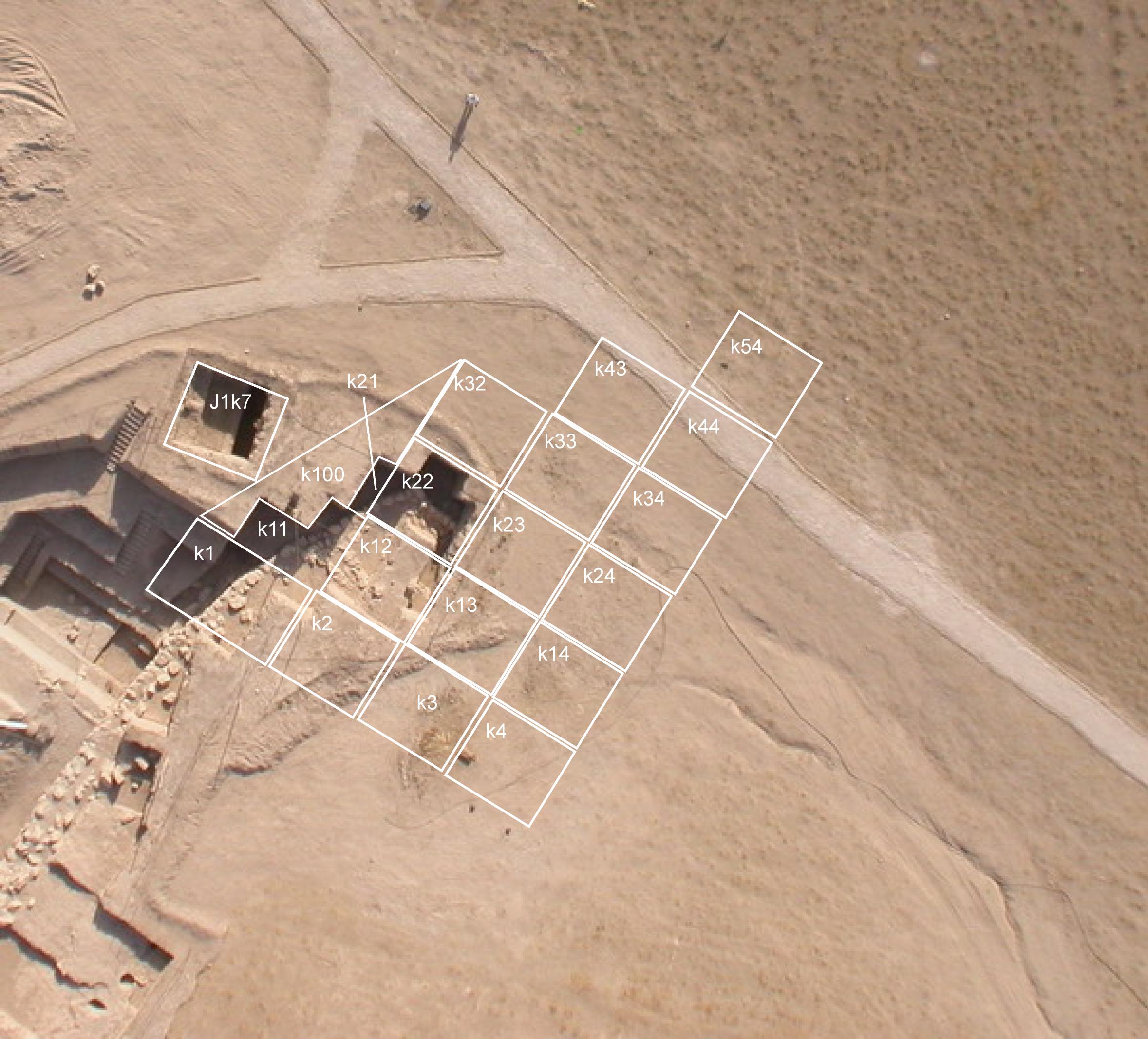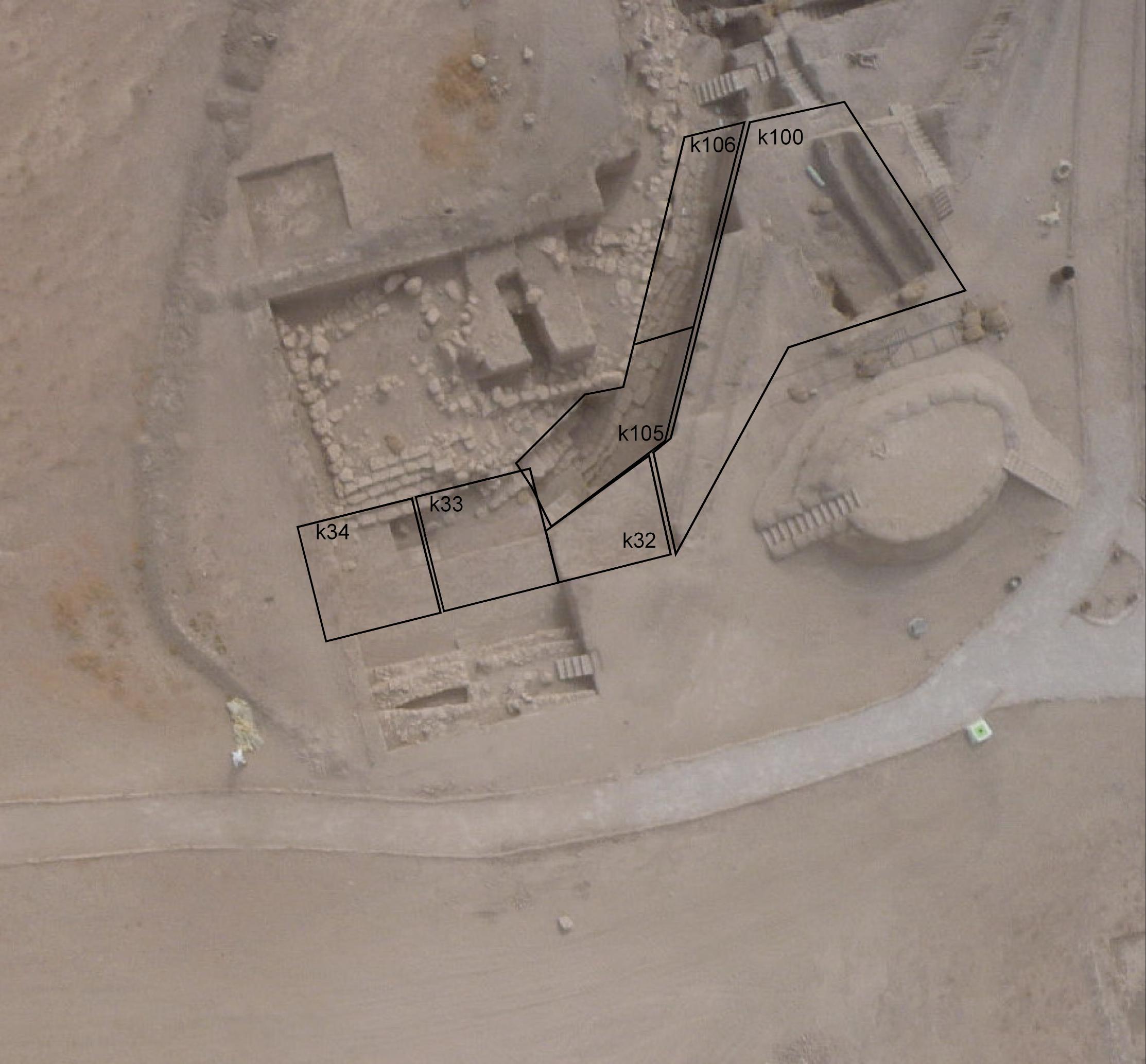Back to top: Chronicle
Background
Excavations in J1 during the 2005-2006 seasons exposed the full height of the revetment wall, its two escarpments and the plaza which extended south from the face of the wall. There were only two phases represented by the ceramics. The highest was Mittani, while directly underneath was Early Dynastic III. There was no evidence of intermediate phases. (A complete explanation is provided in the J1 Chronicle.)
In the last days of the J1 excavations in 2006, the westward extent of the wall and its later escarpment were exposed as far as their turn to the north. In the vicinity of the turn, four wall components could be seen:
- the main revetment wall did not continue further to the west.
- a smaller, higher wall at the west end of the revetment wall turned to the north.
- the stones of a lower wall could be seen oriented to the northwest.
- a double line of surface stones extended to the north from a point about 10 meters from the revetment wall’s end.
In order to devote sufficient resources to enhance our understanding of the revetment wall system west of the deep sounding in J1, we decided to establish a new excavation unit, J5.
Back to top: Chronicle
Pre-excavation History (1999-2007)
In 1999 a German team headed by Perter Pfalzner exposed a monumental staircase on the BA temple mound. It was flanked by a large stone wall discovered in a geographical survey in 2000 and began to be excavated by the German team as unit B6. In 2003 we began to explore the extents of this wall as unit J1.
Unit J1 excavations began in earnest in 2005 and 2006 exposing a larger portion of the wall to the south of the staircase and exposing the western edge of a very large plaza where it joined the wall. A result of these excavations was the identification of both third millenium and Mittani material in close proximity. Following a small excavation during the 2007 study season, the attention of the J1 excavations focused on the base of the wall and the plaza in 2008. Exploration of the wall further to the south and west was assigned to a new unit, J5.
Back to top: Chronicle
Excavations in 2008
Excavations began on July 13, 2008. The aerial photo from August 2007, taken after the excavations in the westward extension in J1 were completed, shows the situation on that day.
The new loci, k3, k13 ,k23, k33 and k43; k14, k24, k34, k44, and k32 were defined at the beginning and served as the main squares in the first season.
Loci to the south, k1, k2, k11, k12, and k21 had already been excavated in 2007 as part of J1. Although some have irregular shapes, the features in them were incorporated into J5 as if they had been excavated by us.
Locus k100 has an irregular shape and reflects the soil column that was "left over" as partial squares were excavated as the wall was traced to the west and north by excavators from J1.
Locus J1k7 is a remnant from early excavations in J1. It has a different orientation and its purpose was to find the plaza floor to the southwest of the revetment wall.
|
|
| 
|
Back to top: Chronicle
Westward Mittani retrenchment (2008)
In the first season of J5 (2008), we explored the extent and characteristics of the revetment wall west of the deep excavations of J1. The geo-physical survey had indicated a weak trace to the north of the western part of wall that had previously been excavated. There was a strong trace of a rectangular object along that line and a weaker north-south trace about 10 meters to the west which then turned to the west.
The primary goal of the 2008 season was to expose these features and determine their function. A secondary goal was to verify if a link existed between the wall system and the palace, perhaps by way of a large service building at the palace edge. This link would have been investigated by a separate excavation unit, A21.
The main finding was a large staircase constructed of dressed stones and rising from west to east, more or less toward the top of the temple mound. Adjacent stone work served to mirror,on a smaller scale, the wall and apron system of the great staircase to the east, exposed as a part of J1. The associated ceramics were Mittani, with small amounts of Middle Assyrian atop. We conclude that the staircase and wall system comprise a western addition to the monumental stonework to the east necessitated after the grand staircase, apron and wall became covered by successive layers of accumulations. The function was to prolong the use of the sacred space as long as possible.
We also exposed a series of low stone walls running north to south about 10 meters west of the staircase. However, we were not able to establish a direct correspondence to the traces on the geo-physical survey.
Finally, we exposed more of the southern face of the early revetment wall, approximately to the top of what was the second escarpment originally found in J1.
Back to top: Chronicle
Excavations in 2009
Excavations began on 20 July 2009 and ended on 27 August 2009. The results are shown on the right, a kite photograph taken on 18 September 2009.
We focused this year's excavations on exposing the revetment wall systems and their protective structures, including escarpments and weirs. Although we did some minor work in loci which were active last year (k32, k33, k34, and k100) most of our investigations were done in the relatively narrow space between the south and west faces of the Early Dynastic III revetment wall and the high north and east baulks of k100 and k32.
For convenience we split this region into two loci, k105 and k106 (both were combined briefly at the beginning of excavations for cleaning.)
|
|
| 
|
In locus k106 we exposed the EDIII stone escarpment, and a later layered baqaya addition. Also, we excavated part of the top of an earlier wall upon which the early revetment wall was built.
In locus k105 we exposed the northward and western extension of the stone escarpment, thereby showing that the rough and cut stone revetment walls were built at the same time We also discovered three diffent stone and brick structures built to moderate the flow of floodwater. In addition, we also excavated a pebble floor surface associated with the stone escarpment.
Back to top: Chronicle
Early Dynastic wall system (2009)
The late 2008 season’s discovery of a Late Chalcolithic wall below the Early Dynastic revetment wall in J1 focused attention on the shape of the mound upon which the BA temple sits in the LC period. J5 was the ideal place to determine this since we have exposed the westward and northward components for a considerable distance. If the Early Dynastic wall system stops at the turn to the north, then there may be numerous intermediate phases between the higher Mittani staircase and the ED wall. If the ED wall continues to the north, then we would expect to find Late Chalcolithic structures just below it, meaning that the mound was high above the plain at a very early time.
If time permitted we also wanted to excavate a mudbrick wall whose top can be seen below the rows of north-south stones to the west of the Mittani staircase.
The major discoveries include:
- The Early Dynastic wall is protected by two escarpments – the later a layered baqaya one, and the earlier a substantial cut stone structure over two meters wide.
- The ED revetment wall continues to the north, although the material changes from rough to cut stones.
- Mittani accumulations sit directly atop those from EDIII.
- The Mittani staircase rests on the EDIII wall’s northern extension.
- Control of water erosion near the revetment wall was a constant problem from the time the wall was constructed in the Early Dynastic period, until abandonment in the Late Mittani period.
- There is evidence that the EDIII revetment wall system was built atop a Late Chalcolithic wall which followed a similar path.
- There is a high floor which extends to the west and south of the EDIII revetment wall. It is significant because it may link the wall with other high EDIII structures in that vicinity.
In summation, we found that the current shape of the temple mound was determined by pre-EDIII structures which most likely lay just below the revetment wall, its first escarpment, and an associated floor
Back to top: Chronicle
Synopsis of elements per season
Following is a chart indicating the elements that were defined in the various seasons of excavation.
| season
|
loci
|
features
|
items
|
q-lots
|
views
|
| 2008
|
1-4,11-14,21-24,32-34,43-44,54,100-103
|
1-200
|
1-32
|
1-284
|
1-144
|
| 2009
|
104-107
|
201-295
|
33-61
|
285-485, 800-817, 900-917
|
145-230
|
Back to top: Chronicle